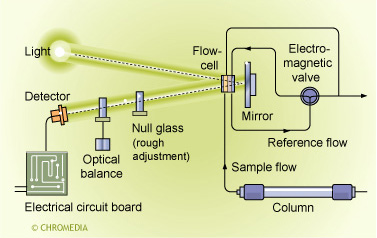Abstract Refractive index detectors monitor the refractive index of column eluent (a bulk property), and are thus universal detectors. The detector monitors refractive index either by measuring the deflection of a light beam passing through an interface with the eluent or by measuring the amount of light reflected by the interface at angles near the critical angle. Refractive index detectors require careful control of temperature and are not very sensitive, operating in the mg/L range.
KeywordsDifferential refractive index, Refractive index, Bulk property, Universal, Temperature, Flow variation, Gradient, Refraction, Deflection method, Reflection method, Critical angle, Thermostat, Prism
LevelBasic
The refractive index detector, also called the Differential Refractive Index Detector, detects solutes by monitoring the refractive index of the column eluent relative to a reference cell containing air, mobile phase, or a transparent material with a specified refractive index. Refractive index detector
A refractive index detector is a universal detector since it monitors a bulk property of the solution. Unfortunately, RI detectors have a very low sensitivity (mg/L range) and are subject to several caveats:
- RI detectors are very sensitive to changes in temperature. Both the detector and column must be thermostatted.
- The detector is sensitive to flow variations. Furthermore, the cell is quite fragile and one should be careful when using high flow rates.
- RI detectors cannot be used in gradient elution since the eluent composition changes during the analysis. The change in eluent composition is reflected in baseline drift. In theory, it would be possible to correct this if the eluent flow were split into column and reference cell flow before the injector. This is not possible in practice, however.
- Most LC detectors are flow-through detectors. Generally their detection is non-destructive, allowing coupling of detectors in series. When an RI detector is used in series with other detectors, it should be the last detector in the series.
 Did you ever try to explain separation to your employees or students? Well, try no more: Lee Polite did it for you in a way which is hard to beat. We will open up one example of his whiteboard class.
Did you ever try to explain separation to your employees or students? Well, try no more: Lee Polite did it for you in a way which is hard to beat. We will open up one example of his whiteboard class. 




